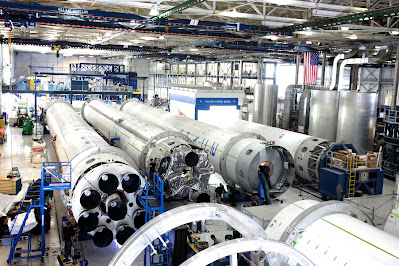•The Industrial Revolution| Unleashing the Power of Intelligent Automation: Strategies for Sustainable Growth
Intelligent automation has brought about a paradigm shift in the business world, offering unparalleled opportunities for growth and "the industrial revolution". However, scaling and implementing intelligent automation successfully is not without its challenges. To ensure sustainable growth and success, organizations must navigate key factors that determine the effectiveness of their automation initiatives. In this article, we delve into these crucial factors and provide insights on how businesses can harness the full potential of intelligent automation at scale.
1. Aligning Automation with Strategic Objectives:
To make a significant impact, intelligent automation must align with the broader strategic goals of the organization. It is essential to identify processes that can benefit the most from automation and establish clear, measurable objectives. This alignment will guide the implementation strategy, enabling businesses to focus their resources on areas that deliver the highest return on investment and sustainable growth of the industrial revolution.
2. Selecting the Ideal Technology Platform:
With a wide range of automation tools available, organizations must carefully select a technology platform that meets their specific requirements. Key considerations include scalability, flexibility, and seamless integration with existing systems. By choosing a robust solution, businesses can automate various tasks and workflows, allowing automation to permeate throughout the organization and maximize its transformative potential for sustainable growth.
3. Embracing Change through Effective Change Management:
Intelligent automation brings about changes in roles and responsibilities within the workforce. It is crucial to proactively communicate the benefits of automation to all stakeholders and involve them in the process. Employing a comprehensive change management strategy, including training and support, helps employees adapt to the new automation-driven environment. By presenting automation as a tool that enhances productivity and augments human capabilities rather than a threat to job security, organizations can foster a positive mindset and ensure a seamless transition.
4. Establishing a Governance Framework:
A well-defined governance framework is essential for the smooth functioning of intelligent automation at scale. This framework involves assigning clear ownership and accountability for automation initiatives, defining performance metrics to measure automation's impact, and regularly reviewing and refining processes to drive continuous improvement in sustainable growth of industries. With a robust governance structure in place, automation remains aligned with organizational goals and adapts to evolving business needs, facilitating sustainable growth and long-term success.
5. Cultivating a Culture of Innovation and Experimentation:
Intelligent automation is an ongoing journey of exploration and improvement. To unlock its full potential, organizations should foster a culture of innovation and experimentation. Encouraging teams to explore new ways of leveraging automation, experimenting with different use cases, and sharing their insights across the organization leads to transformative breakthroughs. By nurturing a culture of innovation, businesses can harness the true power of intelligent automation and drive scalable change throughout the enterprise.
•sharing the news
AT&T, one of the telecommunications industry leaders, embarked on a mission in 2015 to streamline its service delivery operations through the implementation of Robotic Process Automation (RPA). By gradually expanding its automation efforts and integrating Artificial Intelligence (AI) capabilities, AT&T has transformed into an Intelligent Automation (IA) powerhouse for the industrial revolution.
1.Streamlining Operations with RPA:
AT&T initially automated one process within its service delivery group using RPA, and the success prompted the company to expand its automation efforts. Within a year, 350 automation bots were deployed, and this number continues to grow. Recognizing the potential of combining RPA with data science, AT&T integrated AI capabilities such as Optical Character Recognition (OCR) and Natural Language Processing (NLP) into their bots, creating an efficient IA environment to develop the industrial revolution.
2.Establishing the Automation Center of Excellence:
To meet the increasing demand for RPA across the organization, AT&T established an Automation Center of Excellence (COE). This COE played a crucial role in expediting the implementation, development, deployment, and management of automation efforts throughout the company. In addition, AT&T educated over 2,000 RPA developers and empowered various lines of business to form their own automation teams, supported by the COE.
3.Democratizing Intelligent Automation:
AT&T ensured that Intelligent Automation is accessible throughout the company by deploying a secure generative AI platform. Leveraging OpenAI's GPT-4 technology, the platform provides a secure environment for employees to enhance productivity while safeguarding intellectual property. It includes a private "knowledge base" containing AT&T-specific data, enabling employees to access internal documents and materials through chat interactions.
4.Notable AI-powered Initiatives:
AT&T's dedication to AI-powered innovation has led to significant benefits. One remarkable initiative is an auto-notification tool that alerts business customers about potential usage overages. This proactive approach empowers customer care representatives to inform customers in advance, allowing them to adjust their plans accordingly. Additionally, AT&T developed an AI-powered automation tool for state governments, streamlining paper document scanning, filing, and storage while ensuring compliance with regulations. The company also offers a solution for seamless account and phone number transfers for large customers within organizations, ensuring a smooth transition process.
5.The Effectiveness of Interactive Voice Response (IVR) System:
AT&T's Interactive Voice Response (IVR) system plays a pivotal role in customer interactions. By accepting customer requests and triggering bots to initiate secure web forms, AT&T ensures efficient and seamless processes. Once the customer submits the form and the transfer is ready, the bot contacts the customer for final verification.
6.Impressive Results and Ongoing Dedication:
AT&T's commitment to combining RPA, AI, and automation has resulted in substantial annual benefits, with nearly $100 million in productivity gains and cost savings. The company's return on investment typically exceeds 10 times in a given year. AT&T's ongoing dedication to innovation and leveraging intelligent technologies cements its position as a frontrunner in the telecom industry, setting a remarkable example for others to follow.
•Harnessing the Power of Bots: Streamlining Operations with Intelligent Automation
By leveraging bots and artificial intelligence (AI), businesses can empower their workforce, automate repetitive tasks, and unlock new opportunities for growth. This article explores the key strategies and insights shared by industry expert, Mr. Austin, from AT&T, on how organizations can effectively harness the power of bots and maximize their value.
One of the essential aspects of implementing bots successfully is to ensure that they are accessible to a wide range of users, not just data scientists. According to Mr. Austin, only a small fraction of their bots are built within the Chief Data Office, while the majority are developed within the business units. This approach enables non-technical users to quickly adapt and leverage bots for their specific operational needs. By providing centrally funded resources and support, organizations can enable employees who are not data scientists to get up to speed, fostering a culture of innovation and collaboration.
To ensure the ongoing success of bot deployments, it is crucial to track and measure their performance. Austin advises implementing a platform that monitors the functionality and uptime of bots. This proactive approach allows organizations to identify any potential issues or bottlenecks promptly. Furthermore, making bots as reusable as possible promotes collaboration and accelerates the adoption of automation across different departments. By automating the approval process, organizations can remove bottlenecks and expedite the deployment of bots, ultimately driving operational efficiency.
Automation is not limited to the deployment and management of bots alone. Austin emphasizes the importance of leveraging generative AI in an organization's intelligent automation strategy. By developing an automated capability that encourages and recommends AI-enablement for bots, businesses can enhance their value proposition. Generative AI presents a transformative opportunity to augment the capabilities of bots, enabling them to become even more valuable assets within the organization. This approach empowers businesses to stay ahead of the competition by continually unlocking new possibilities and driving innovation.
Making bots accessible to a wide range of users is important for successful implementation. Instead of only data scientists, many non-technical users can create and use bots to meet their specific needs. This approach promotes collaboration and innovation by providing centralized resources and support.
To ensure bots continue to perform well, it's crucial to monitor their performance. By using a platform that tracks bot functionality and uptime, organizations can quickly identify any issues. Reusing bots across different departments promotes collaboration and speeds up automation adoption. Streamlining the approval process through automation eliminates delays and improves operational efficiency.
Automation goes beyond deploying and managing bots. It's essential to leverage generative AI in an organization's automation strategy. Developing an automated capability that suggests AI-powered features for bots adds value to businesses. Generative AI allows bots to become even more valuable assets, empowering organizations to stay ahead of the competition and drive innovation by unlocking new possibilities.
In conclusion, successful implementation and scaling of intelligent automation require a strategic approach that takes into account various crucial factors. By aligning automation initiatives with strategic objectives, selecting the right technology platform, embracing change through effective change management, establishing a robust governance framework, and fostering a culture of innovation, organizations can optimize operations, drive efficiency, and achieve sustainable growth. Intelligent automation, when thoughtfully implemented, becomes a catalyst for a future where businesses thrive in the era of digital transformation.

